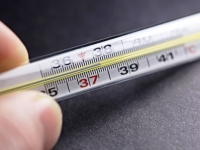Temperature 37.2 – reason to consult a doctor: what will tell subfebrile
 A serious illness that can develop in the body imperceptibly for the person himself can be “declared” by a slightly increased body temperature. Low-grade fever (37-37.5 ° C) can last for several weeks or months, but does not bother the person. Meanwhile, subfebrile condition can be a symptom of a sluggish inflammatory process or a serious disease.
A serious illness that can develop in the body imperceptibly for the person himself can be “declared” by a slightly increased body temperature. Low-grade fever (37-37.5 ° C) can last for several weeks or months, but does not bother the person. Meanwhile, subfebrile condition can be a symptom of a sluggish inflammatory process or a serious disease.
Body temperature: norm and deviation
So what is the norm and deviation from it, if we are talking about the temperature of the human body? The classic normal temperature of a healthy person is 36.6 ° C. However, these indicators are not always stable and may change under the influence of a number of factors. And this does not mean that something is wrong with you. Temperatures can vary from 35.5 to 37.4 ° C due to the influence of climate, biological rhythms, and time of day.
Influence on body temperature fluctuation time of day, general condition (spleen or depression), fatigue, hormonal processes (pregnancy, menstruation, menopause). Therefore, such a range in terms of temperature is not a pathology, a person may be all right. The temperature may rise by several degrees after an active workout in the gym or a hearty lunch, children experience an increase in performance if they have cried for a long time. Lowering the temperature occurs with age, with aging: and – for men, the figures are lower than for women. But when the temperature in the range of 37-37.5 ° C lasts for a week or more, and the indicators do not change at any time of the day, then this may be a symptom of the disease.
Low-grade fever is a symptom
Physicians consider subfebrile temperature rather difficult question. Since it is difficult to diagnose what kind of “messenger” is subfebrile. If a person has suffered from ARVI or another disease for a long time, then the cause of the increased temperature is easier to establish. This may be the so-called “temperature tail”: when the temperature after the disease is kept from a week to six months. Here it is important to monitor your condition, to prevent recurrence. It is important not to panic, but to follow the dynamics of the blood test and strengthen the immune system. Especially carefully should monitor the body temperature and health in children.
But often the temperature becomes subfebrile without visible signs of any disease. So, a subfebrile condition can cause:
– inflammatory process of sluggish nature in the body, both local and general
– chronic tonsillitis (prolonged inflammation of the pharyngeal and palatine tonsils)
– pneumonia (pneumonia)
– hepatitis
– chronic pyelonephritis (long-term inflammatory processes in the kidneys)
– gastritis and ulcerative colitis (inflammatory processes in the gastrointestinal tract)
– dysfunction of the cardiovascular system
– TORCH infections (herpes, toxoplasmosis, etc)
– tuberculosis
– malignant tumors
– anemia (anemia)
– allergic reactions
– worm infestations and other parasites
What to do when subfebrile temperature
It is best to consult a doctor. Only a specialist can determine whether you have a problem or not by conducting a series of studies and asking the patient to follow certain recommendations. It will be necessary to measure the temperature at different times of the day (in the morning and in the evening) for several days and record the readings in order to build a temperature curve.
Then the doctor will analyze the situation and prescribe a number of diagnostic studies, as well as a consultation with narrow specialists: a cardiologist, an infectious diseases specialist, a dentist and others. Based on the results and the conclusion of a doctor, treatment is prescribed.



